Saturday, April 10, 2004
Æ denarius, Rome, Gallienus, Göbl 682t
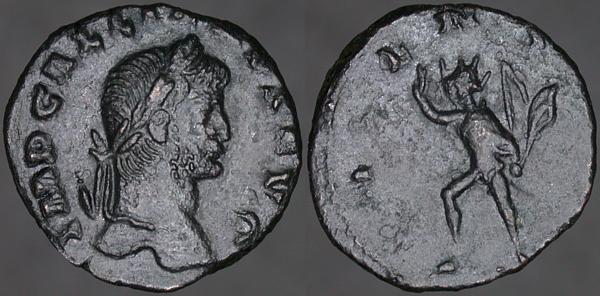
IMP GALLIENVS AVG, Laureate head right | ORIENS AVG, Sol advancing left, raising hand left, holding whip right, cloak flying right.
The last time I posted a denarius of Gallienus I noted that they weren't an important part of the economy in the mid-3rd century. Their relative rarity, though, makes them especially desirable to collectors, even when they are in less than perfect condition. Göbl attests four examples of this coin, which only means that he knew of four published examples, and isn't an attempt to count how many exist. I think this is as nice as the photograph in the book, even with the partial legends on both sides.
One thing a collector wants is what nobody else has. What almost nobody else has will do, if it must.
Friday, April 09, 2004
Æ25, Augusta Traiana in Thrace, Gallienus, Varbanov 503
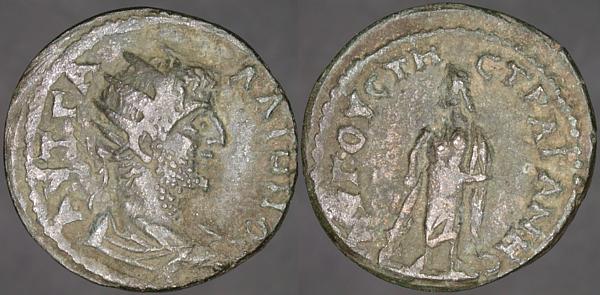
ΑVΤ ΓΑ_ΛΛΙΗΝΟC, Radiate draped bust right | ΑVΓΟVCΤΗ_C ΤΡΑΙΑΝΗC, Asclepius standing facing, head left, holding serpent-entwined staff left.
(Ulpia) Augusta Traiana is today Stara Zagora, in Bulgaria, which claims 8 millenia of habitation.
Last year I posted these four coins of Serdica, featuring Asclepius and related themes. During the next few weeks I'll show some of the wide variety that seems to characterize Augusta Traiana.
Thursday, April 08, 2004
Billon antoninianus, Samosata, Salonina, Göbl 474f
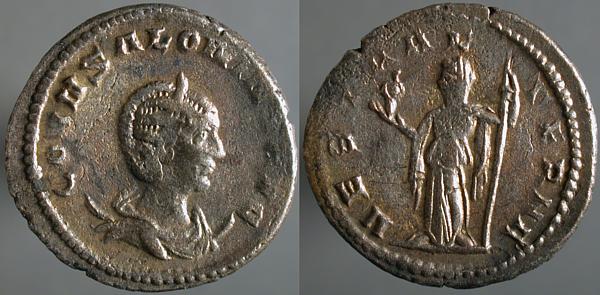
CORN SALONINA AVG, Diademed draped bust right on crescent | VESTA AETERNA, Vesta standing facing, head left, holding scepter right and cultus statue (?) left.
Vesta was the old Roman goddess of the hearth, her priestesses the Vestal virgins.
Wednesday, April 07, 2004
Billon argenteus, Treveri, Licinius, 318-319 CE, RIC 212var
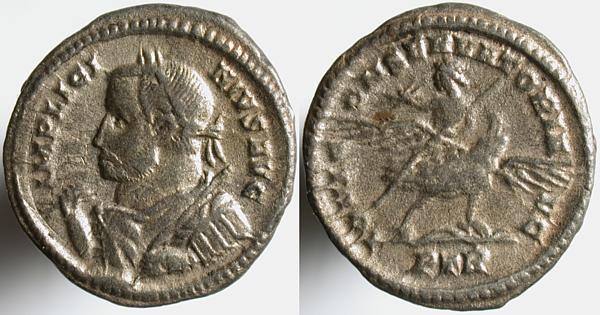
IMP LICI_NIVS AVG, Laureate, draped, cuirassed bust left, mappa in raised right hand, sceptre across left shoulder | IOVI C_ONSERVATORI A_VG, Licinius, sceptre in left hand, thunderbolt in right, astride an eagle wings spread right, head left. PTR in exergue. (RIC does not show officina P for variety with wings spread)
Treveri is today Trier, Germany.
Licinius reigned during the dissolution of the tetrarchy, from 308 to 324, when he abdicated after a series of military defeats and was soon executed.
The argenteus was a short-lived denomination, beginning as a silver coin in Diocletian's currency reform circa 293. Almost immediately it was debased with copper and is not usually seen in white metal this late.
Tuesday, April 06, 2004
Æ20, Flaviopolis in Cilicia, Gallienus, cf. Lindgren III, 834
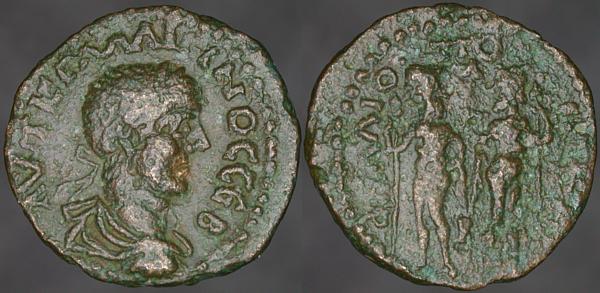
ΑVΤ Κ ΓΑΛΛΙΗΝΟC CΕΒ, Laureate draped cuirassed bust right | Φ[...]ΛΙΟ_ΠΟ[...], The Dioscuri standing facing, each looking at the other, holding a scepter.
A recent acquisition, and my first from this city. Google doesn't turn up much information on Flaviopolos, but it must have been named for the family of Vespasian, presumably during his reign of that of one of his two sons. That need not, of course, be its original name.
While I can't find this coin, for Gallienus, in any of my books, and while the reverse legend is both partly obscured and a bit garbled (ΛΙΟ should be VΙΟ), I'm still comfortable attributing it to Flaviopolis, since it's a reverse design that was used there for a number of previous emperors, including Philip II in the attribution listed in the title line of the post.
The Dioscuri, featured on the reverse, provided the Romans with a nice parallel for their own famous twins Romulus and Remus. The Dioscuri are often featured on denarii of the Roman republic.
Just above and to the left of the head of the leftmost of the twins is a small pellet that represents one of the two stars that feature in images of the Dioscuri, a simplified representation of the constellation Gemini.
Monday, April 05, 2004
Billon antoninianus, Rome, Gallienus, Göbl 474f
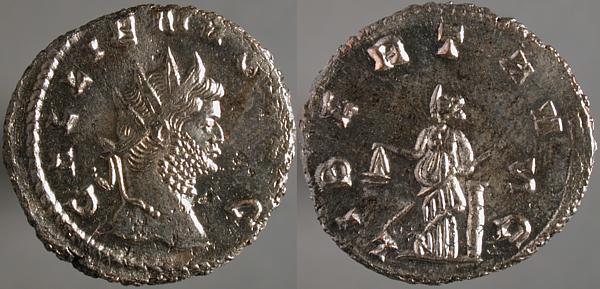
GALLIENVS AVG, Radiate head right | LIBERT AVG, Libertas standing facing, head left, leaning on a cippus right, holding cap left and transverse scepter. S in right field.
The coin claims that the emperor has provided the one thing that no Roman had now, 3 centuries after Julius Caesar became dictator for life: liberty.
In her right hand, Libertas holds her conventional attribute, a Phrygian cap, said to have been used by the Romans as a mark of manumission. It survives as a symbol of liberty, and was worn by the personification of Liberty on many US coins prior to our ill-advised adoption of Presidential portraits, and held on a pole on the seated liberty design.
Sunday, April 04, 2004
Æ31, Tarsus in Cilicia, Gallienus, Hesperia xl-xli 524
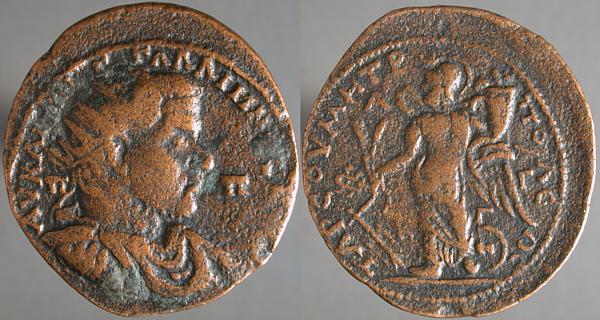
ΑV ΚΑΙ ΛΙ_Γ ΓΑΛΛΙΗΝ[ΟC CΕΒ], Radiate draped cuirassed bust right. Π before and behind | ΤΑΡCΟV ΜΗΤΡ_Ο_ΠΟΛΕ_ΩΝ, Winged helmeted Athena Panthea standing facing, head left, holding rudder, sistrum, and grain ears left, and cornucopia right. Shield at feet right. Α / Μ / Κ in left field, Γ / Γ in right.
Pictures from an expedition to Tarsus in 1919-20.
The reverse shows Athena with the attributes of many other goddesses: the wings of Nike, the rudder of Tyche, the sistrum of Isis, the grain ears of Demeter, a cornucopia held by many goddesses and personifications, and her own shield at her feet.
A convenient kind of goddess when you need to cover all the bases but only have time to make one sacrifice.
Last coin of Tarsus for a while, I think.

